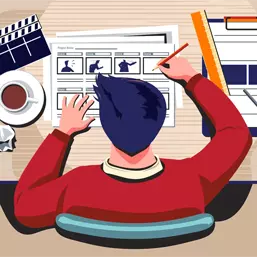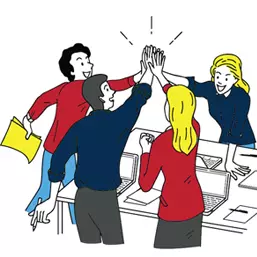
Instruments and Methodologies for Group Work
Man is a tool-using animal. Without tools, he is nothing – but with tools, he is all.
– Thomas Carlyle
Introduction
Because writing in collaboration can be a time-consuming activity, it is always a good idea to use a variety of tools and methods to assist in ensuring that work is flowing smoothly and that progress is being made. Larger projects almost always call for some kind of plan or guidance, whilst smaller projects might only call for closer coherence among the team members. As is the case with all types of collaborative work, aspects such as the nature of the project and the employees who are participating in it will better define which tools or procedures work best for producing the greatest possible outcome.
Storyboards and Outlines
The use of some kind of outline or storyboard as a tool for collaborative writing is becoming increasingly common. These tools are designed to map out a project and help all members of a team know where to start and finish, while also identifying a feasible route in between those two points. The most effective use of an outline is to write down key ideas and illustrate a progression of how those points are addressed throughout the project.

They frequently take the form of bullet points and have relatively little specifics. Storyboards are useful tools that may be applied to larger projects since they make it possible to present additional details all at once. They give the creator the ability to illustrate points with pictures and icons, as well as add text and phrases to identify procedures and important points of the project. In addition, they give the designer the ability to add text and phrases. When an outline or storyboard is presented at the beginning of a project, employees are better informed about what is planned to occur and what their part in the project will be in order to better prepare themselves for it.

Cooperative Efforts in Planning
It is usually helpful to do some planning ahead of time, but this is especially true when working in groups. It is to everyone’s advantage to let the team cooperate and plan the project together, even though management or supervisors must make some decisions. For example, it is helpful to let the team decide how to assign work and when to have frequent meetings to discuss.
A significant portion of the planning that is done in collaboration covers other parts of the project as well, such as the reason for the project, the people who it is intended for, how the project will be organized, and how the various tasks will be carried out. This kind of planning can be done in group talks or through smaller employee sessions, but it is essential to have some form of record of the planning that takes place, such as maintaining an employee log or a process chart in the area where the work is being done. Because of this, individuals of the team are able to examine the various stages of the planning process and understand where their contributions are likely to be most helpful.
Brief check
Employees are better equipped to engage with their colleagues and generate projects in less time and with fewer impediments now that so many new collaboration tools and other technology innovations aimed to make writing more efficient have emerged.
Revision Carried Out in Collaboration
After every member of the team has finished the first draught of their respective assignments, the members of the team will engage in collaborative revision to merge their individual contributions into a single, comprehensive draught. The act of collaborative revision will look different depending on the type of cooperation strategy used. For instance, several approaches call for a more intimate gathering to evaluate the contributions made by members and figure out how those contributions will fit into the overall project.

Other tactics call for the entire group to collaborate on the editing of previous draughts in order to produce the final product. The goal of collaborative revision is to give each member of the team an opportunity to take part in the revision process, to make them feel as though their contribution is valuable, and to ensure that their opinions and insights will be taken into consideration rather than ignored. This can be accomplished through any of a number of different strategies.
Cooperation and Unity Within the Team
The cohesiveness of a team is essential to effective collaboration because it guarantees that members of the team are able to cooperate in order to achieve the shared objective and do not allow differences in viewpoints or personal agendas to drive a wedge between them. When a group has a high level of team cohesion, the members of the group will experience higher levels of motivation, which will lead to improved performance not only for the individuals but also for the team as a whole.
Additionally, cohesiveness within a collaborative team helps members concentrate more on the group’s objectives and guidelines, and even improves group communication. There are four primary stages in the progression of a group, and it is essential that the group manage each stage carefully and move together through the stages of “Norm” and “Perform” jointly.
Brief check
E-mail, voicemail, instant messaging (IM), VoIP video calls (or voice over IP), online calendars, wikis, and shared document workspaces are examples of collaboration technologies.
- The group is only beginning to take shape during this stage, which is referred to as “forming.” The members of the team are concentrating their attention mostly on themselves at the moment.
- Storming is the stage in which conflict first manifests itself, and it is during this stage that future difficulties for the group can be determined.
- Norming is the point at which cohesiveness first starts to take place. The members of the team start to develop trust for one another and begin to talk with greater candor. • Performing is the stage where the group finally gets together to work toward the common goal. This is the stage where they are performing.
Practical Application
Jefferson was getting ready to start work on the new business handbook, and he was assembling his new team of collaborators. After he had recruited his current team members, he convened a meeting of the entire group to talk about the project in its entirety. He utilized outlines to represent the many portions of the guidebook that would need to be finished for it to be considered complete. After then, he asked the group for assistance in planning the various actions that were necessary to finish these portions.
Just before the meeting was adjourned, Jefferson requested that numerous members collaborate on certain parts and appointed several individuals to the role of liaisons between the various’ groups.’ Although they were all working on separate projects, Jefferson wanted everyone in the group to have the impression that they could freely communicate with one another and that they were staying in step with the rest of the group.





